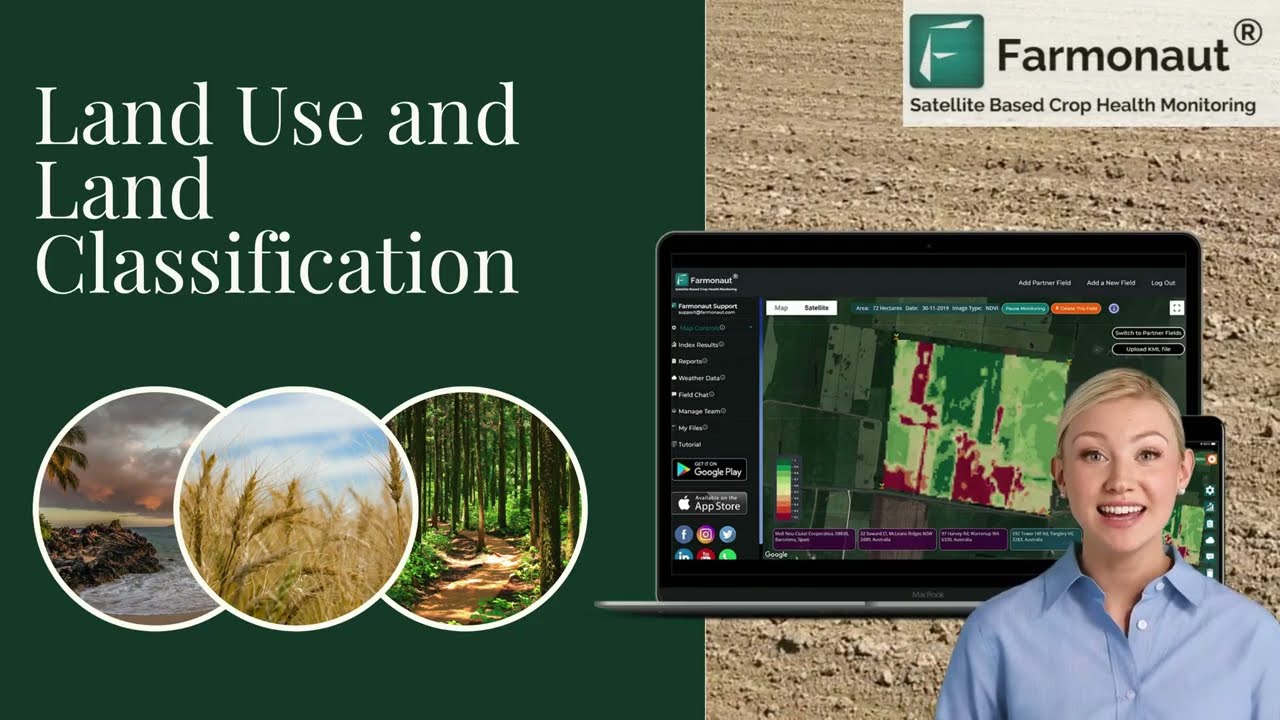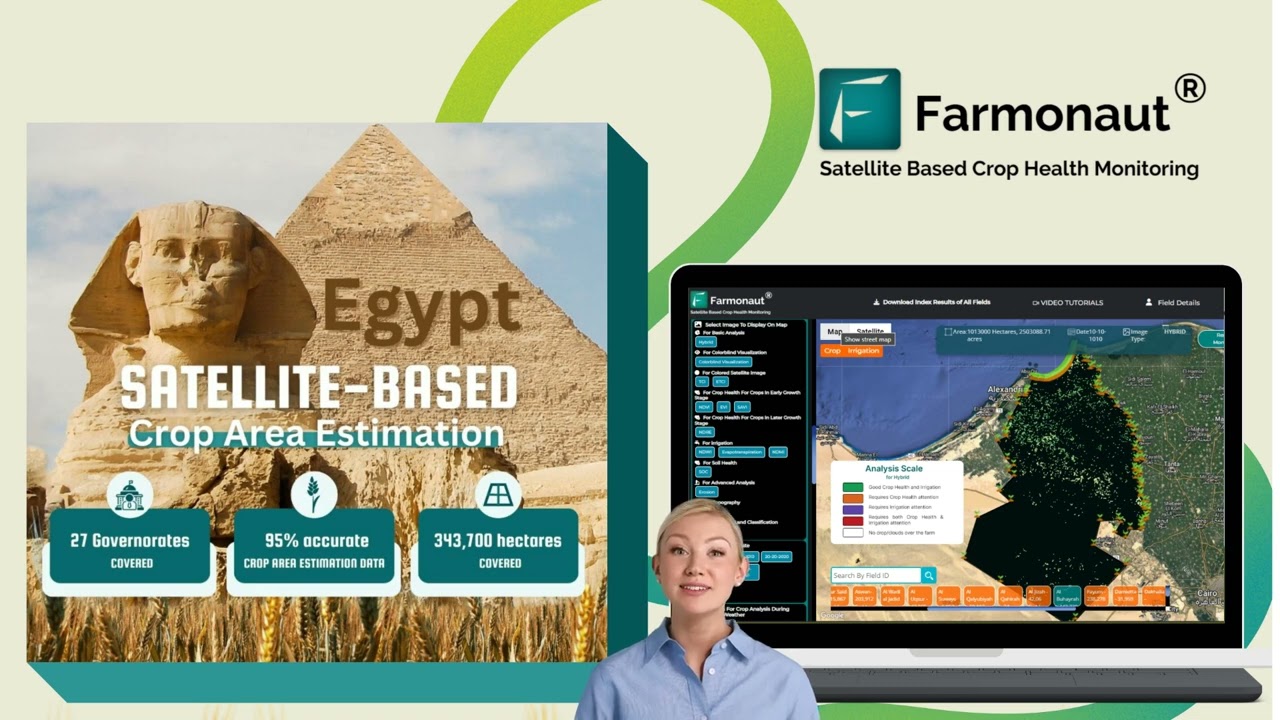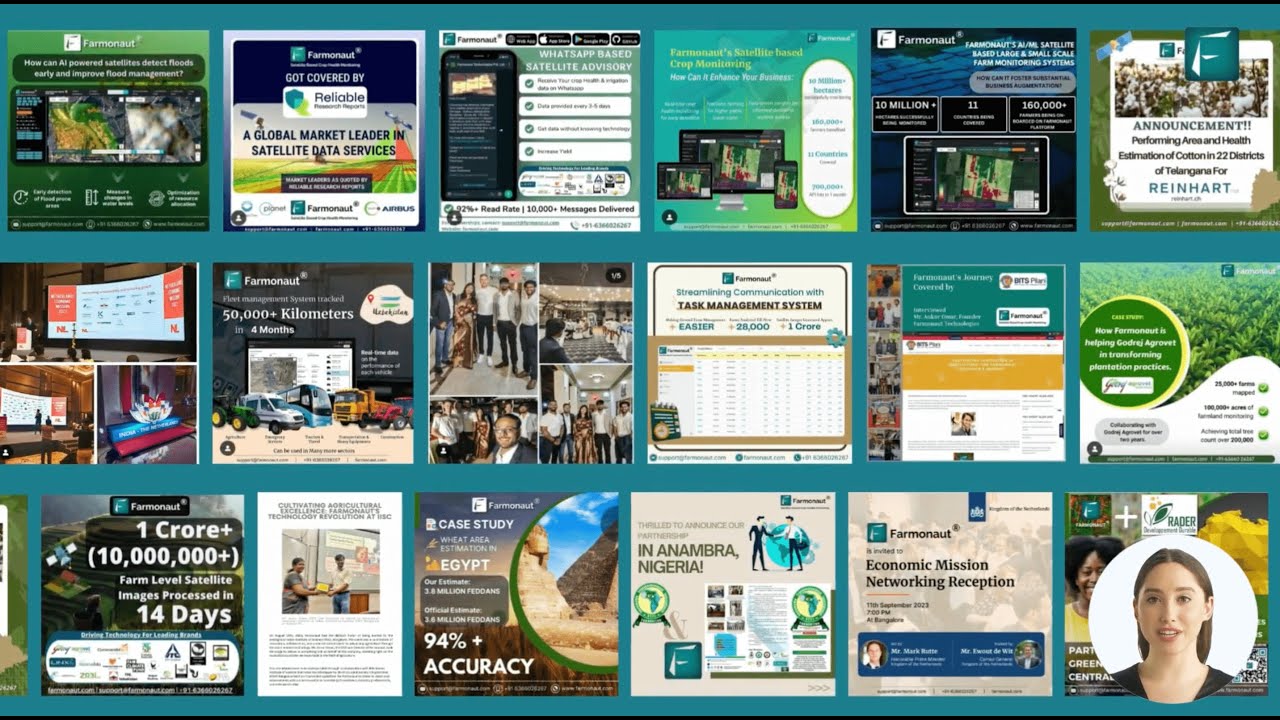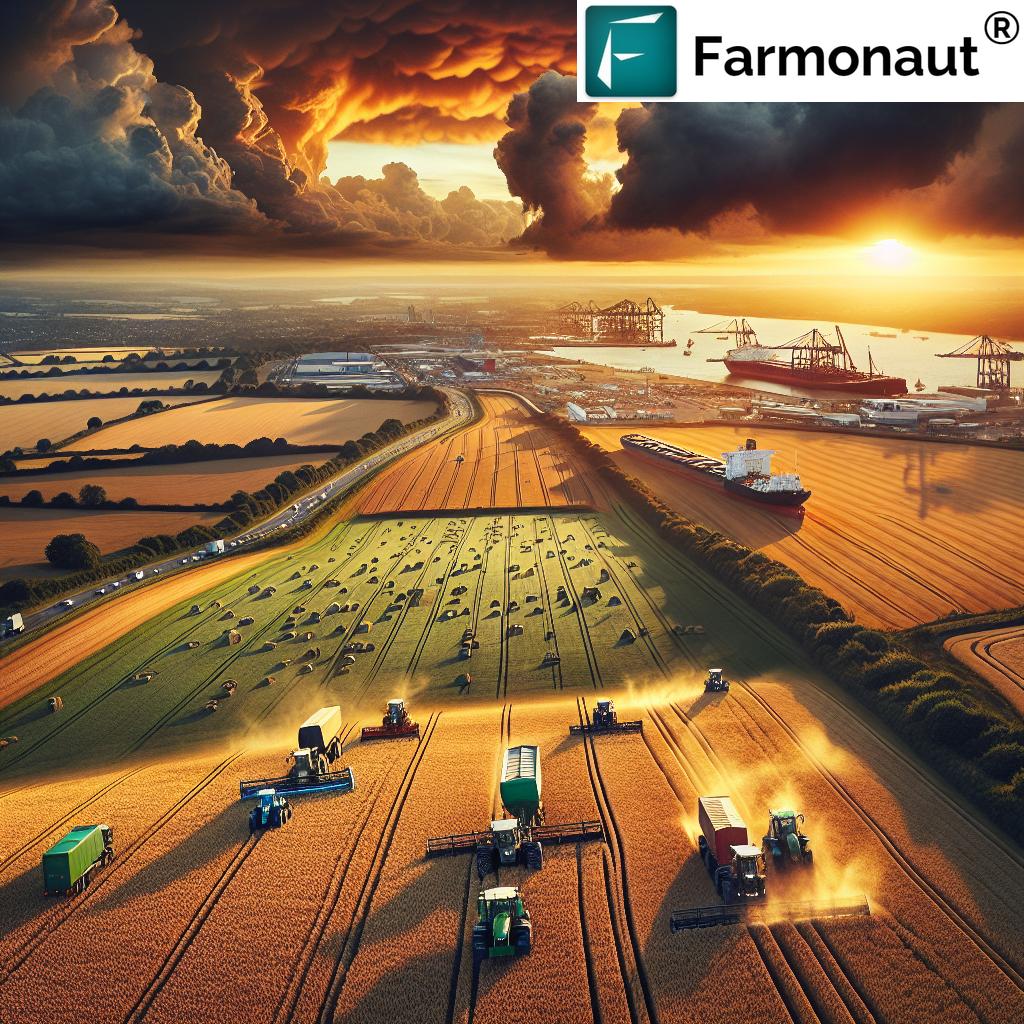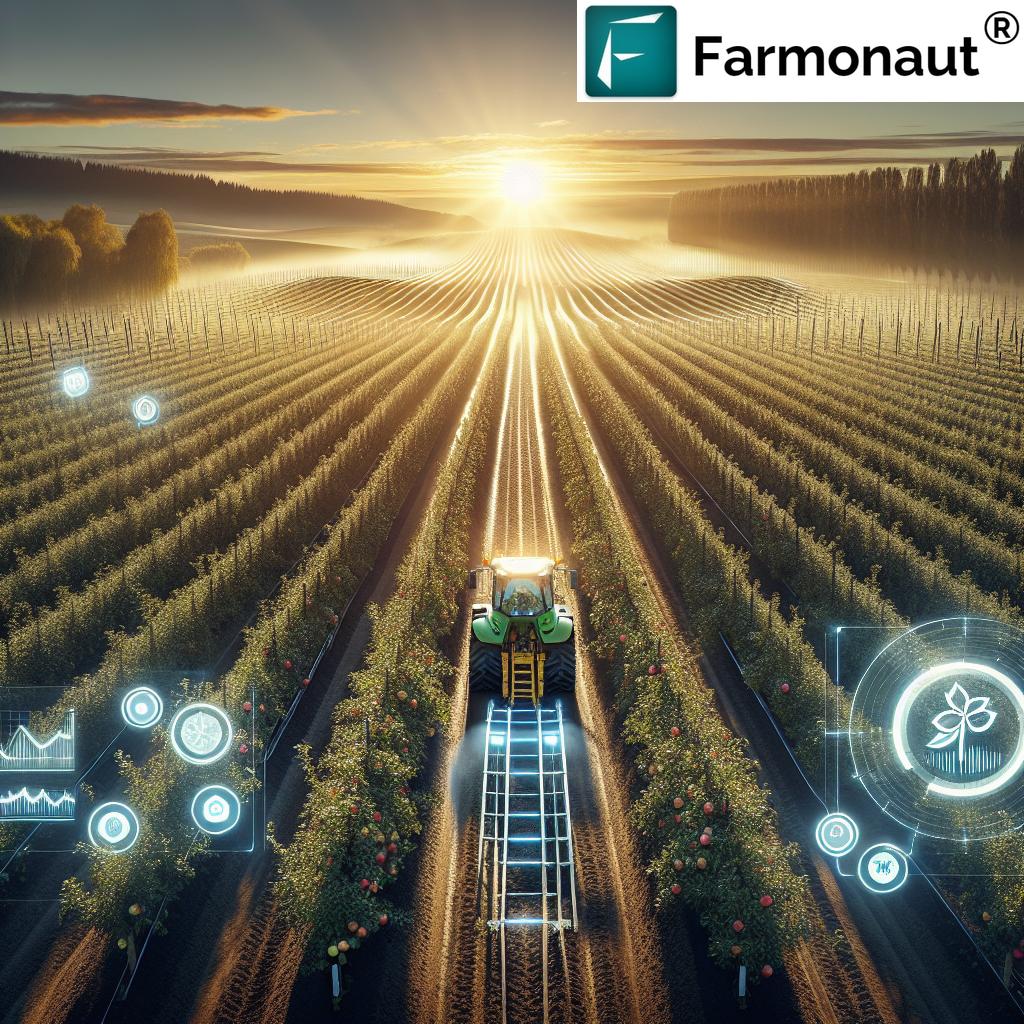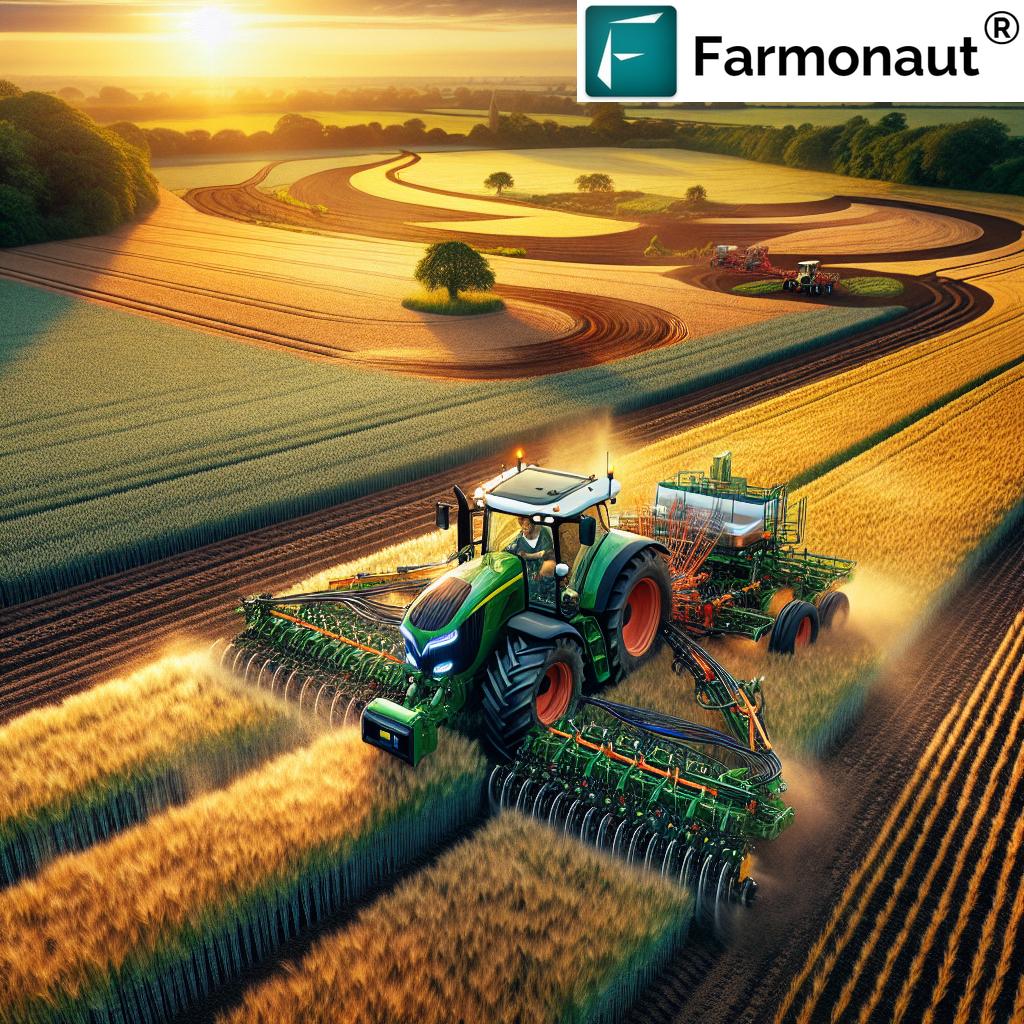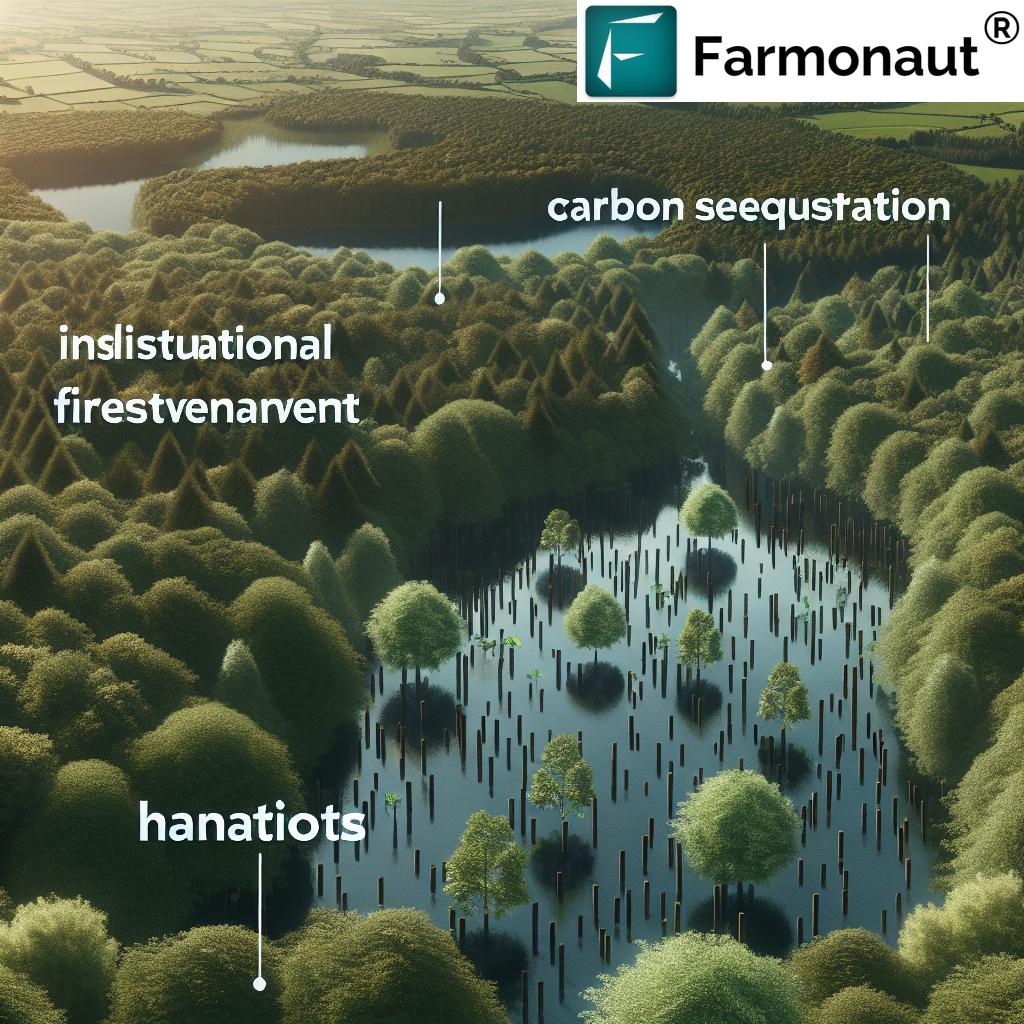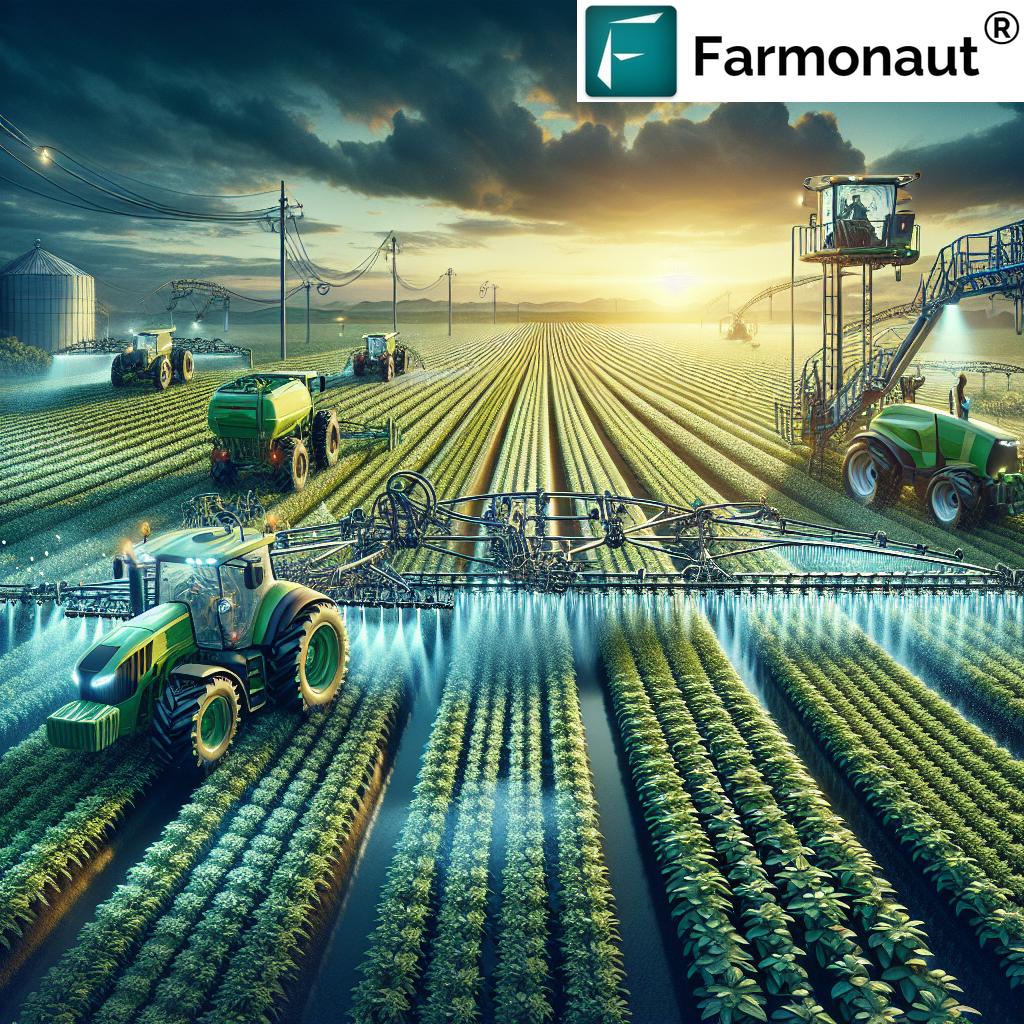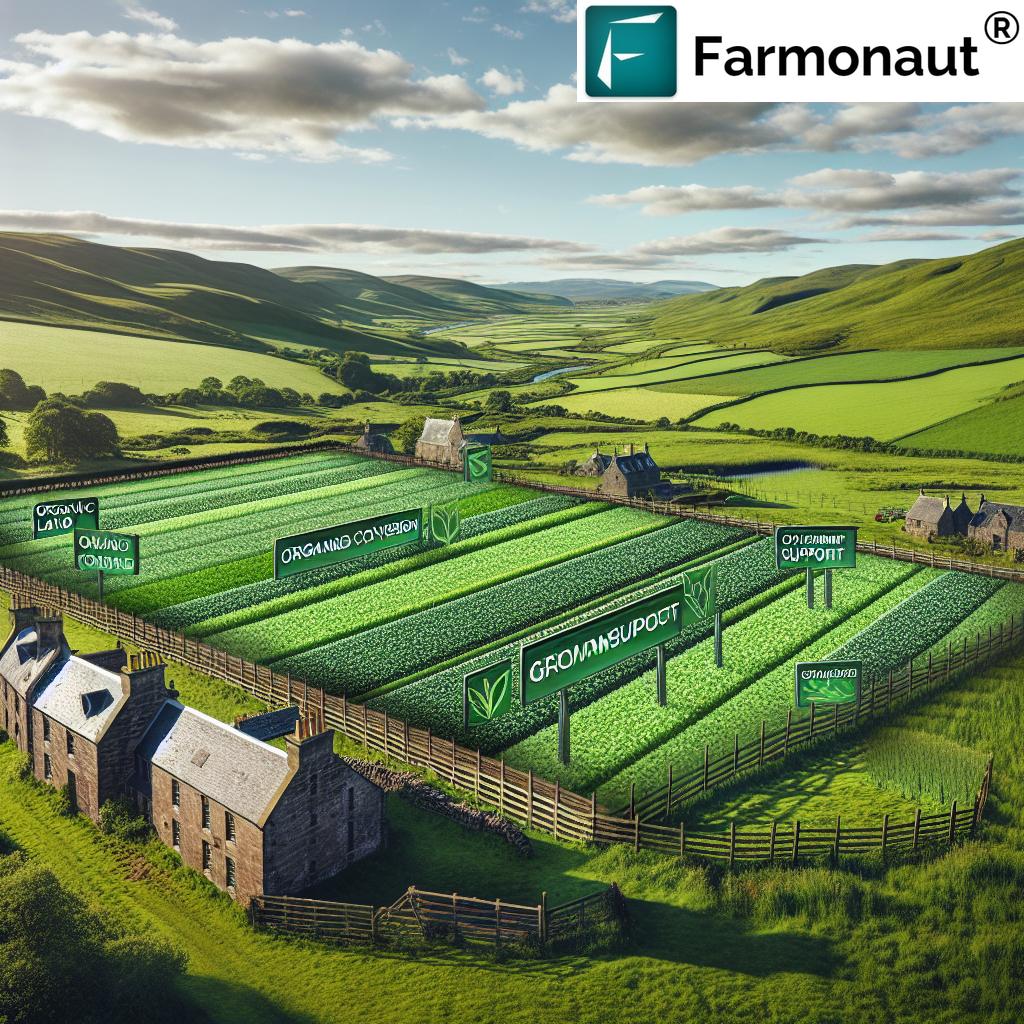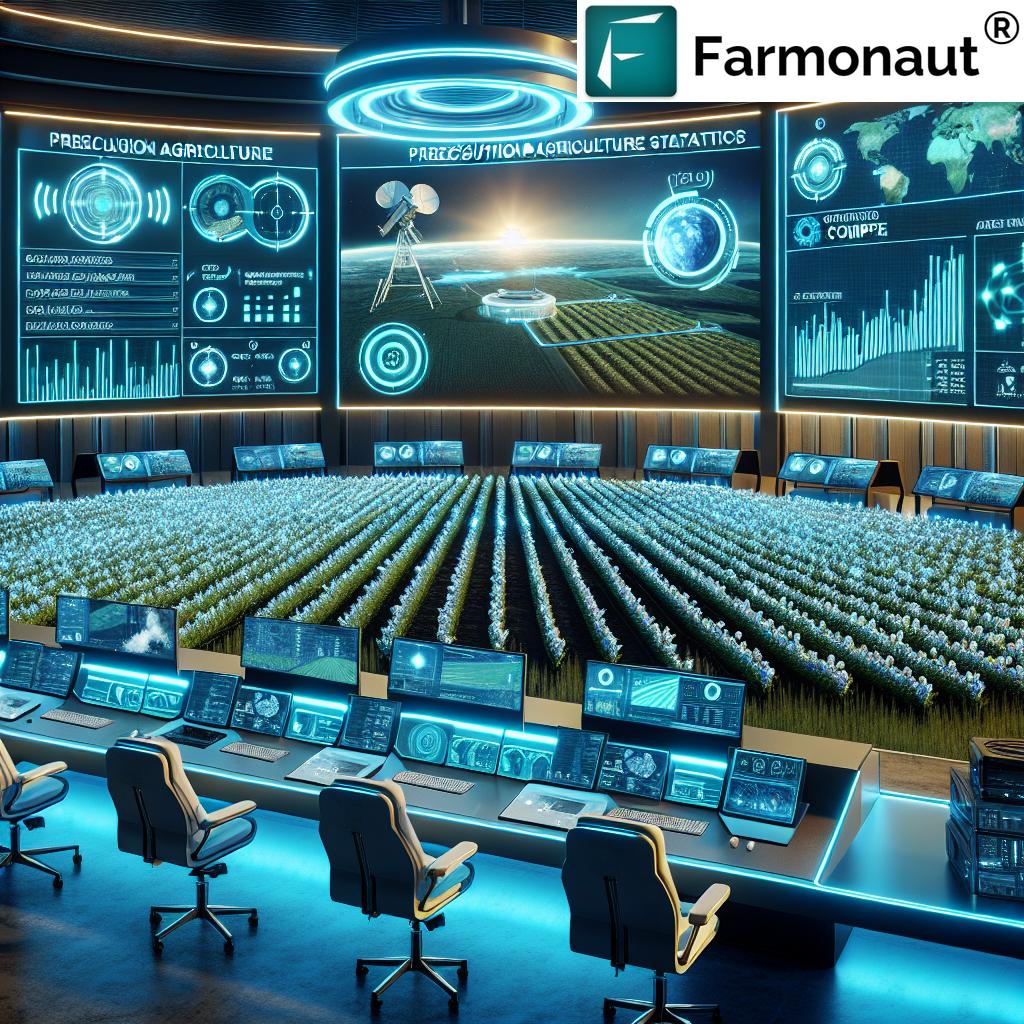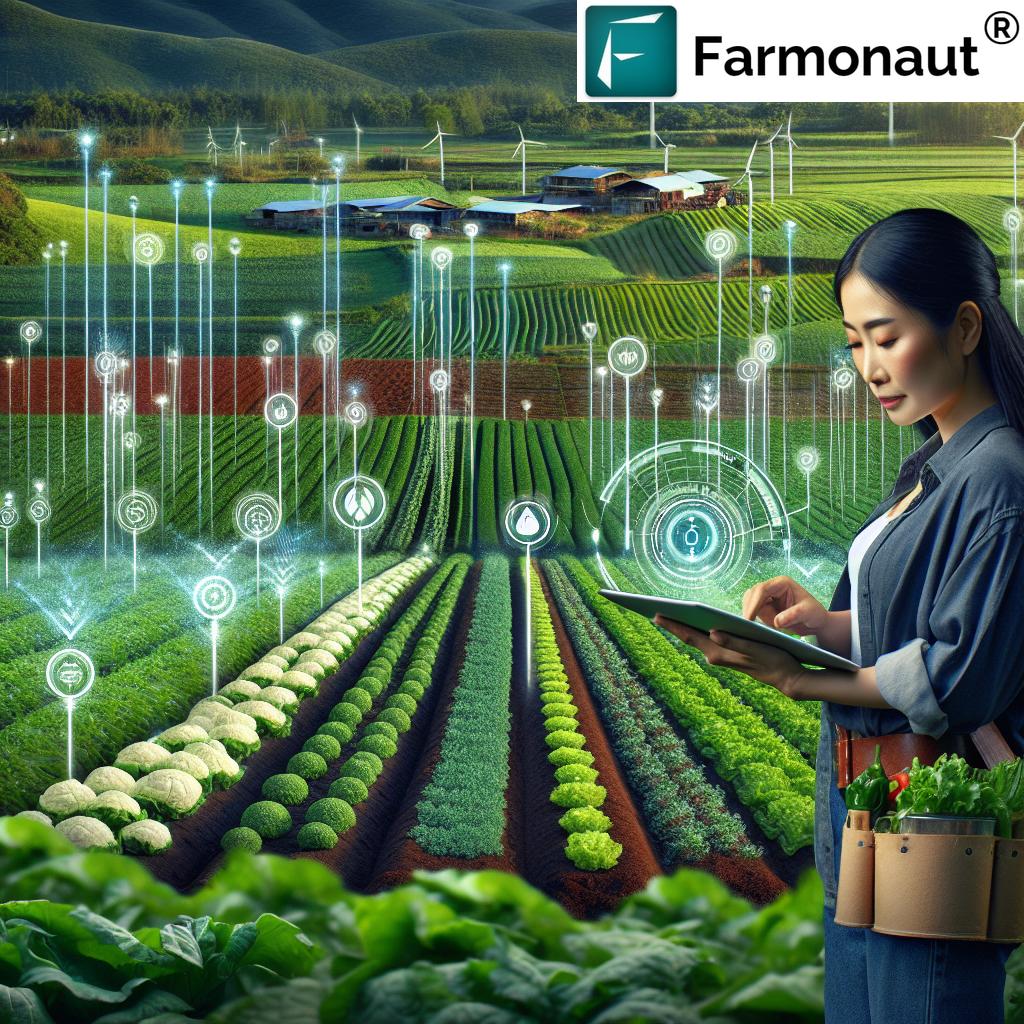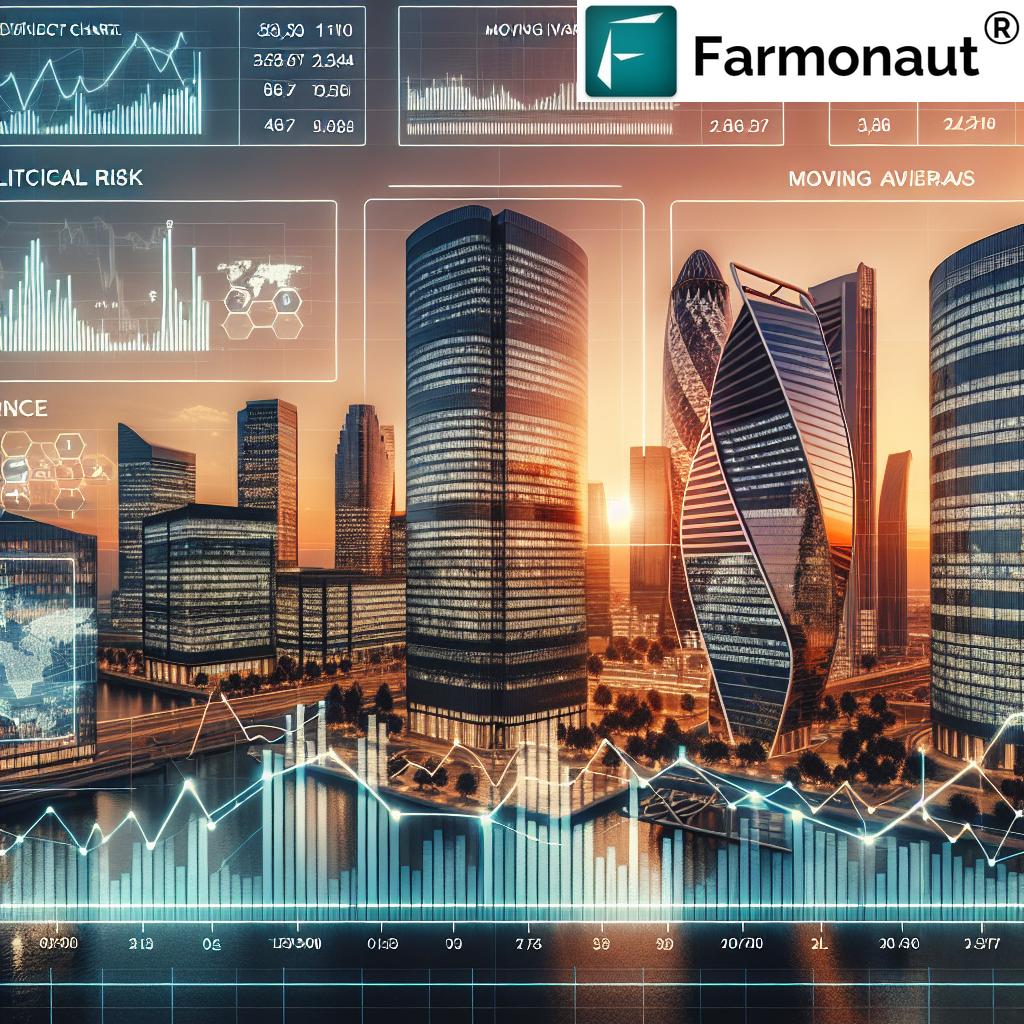Revolutionizing UK Agriculture: How Sustainable Robotics and AI Are Transforming Asparagus Harvesting
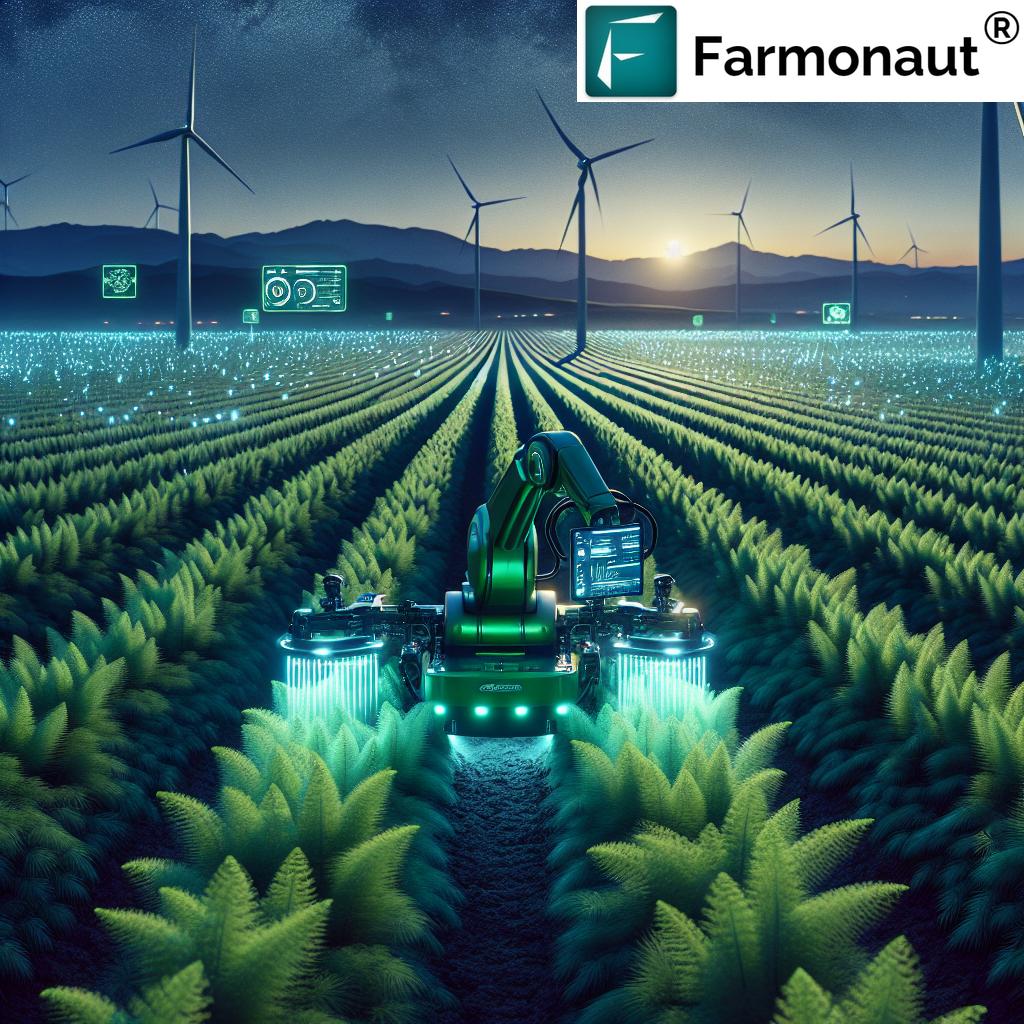
“AI-powered electric farm robots can operate for up to 16 hours daily, revolutionizing labor-intensive tasks like asparagus harvesting.”
In the heart of the UK’s agricultural landscape, a revolution is quietly unfolding. As we navigate the challenges of modern farming, from labor shortages to environmental concerns, innovative technologies are emerging as the heroes of our fields. At Farmonaut, we’re excited to explore how sustainable agricultural robotics and agritech innovations are reshaping the way we grow and harvest our crops, particularly in the labor-intensive world of asparagus cultivation.
The UK’s agricultural sector has long been a cornerstone of our economy and culture. However, recent years have brought unprecedented challenges, from Brexit-induced labor shortages to the growing pressures of climate change. These hurdles have sparked a wave of innovation, leading to the development of cutting-edge autonomous farm machinery designed to address these issues head-on.
The Rise of Robotic Harvesting in UK Agriculture
One of the most exciting developments in this field is the emergence of AI-powered, electric farm robots specifically designed for green asparagus harvesting. These marvels of modern engineering are not just a glimpse into the future of farming; they’re already making waves in fields across the UK.
- Operational Efficiency: These robots can work tirelessly for up to 16 hours a day, significantly outpacing human labor.
- Precision Harvesting: Equipped with advanced AI and computer vision, these machines can identify and harvest only the ripest asparagus spears with unprecedented accuracy.
- Sustainability: Being electric-powered, these robots contribute to reducing the carbon footprint of farming operations.
At Farmonaut, we’re committed to supporting this agricultural evolution by providing farmers with the tools they need to integrate these technologies effectively. Our satellite-based crop monitoring and AI-driven advisory systems complement these robotic innovations, offering a holistic approach to modern farming.
Explore our advanced agri-solutions: 
The Technology Behind Robotic Asparagus Harvesting
The development of these agricultural robots represents a culmination of various technological advancements:
- Artificial Intelligence and Machine Learning: These technologies enable robots to distinguish between harvestable and non-harvestable spears, adapting to different growth stages and field conditions.
- Computer Vision: High-resolution cameras and sophisticated image processing algorithms allow for precise identification and localization of asparagus spears.
- Robotic Arms and End Effectors: Specially designed to mimic human movements, these components can gently yet efficiently harvest asparagus without damaging the plants or surrounding soil.
- Electric Propulsion: Environmentally friendly electric motors provide the power needed for both movement and harvesting operations.
These technologies come together to create a harvesting solution that not only addresses labor shortages but also promotes sustainable farming practices. By reducing the need for manual labor and minimizing environmental impact, these robots are paving the way for a more efficient and eco-friendly agricultural future.
Addressing Agricultural Labor Shortages
One of the most pressing challenges facing UK agriculture today is the shortage of seasonal workers. The asparagus harvest, in particular, has been hit hard by this issue. Traditional harvesting methods require a large workforce for a relatively short period, making it increasingly difficult and expensive for farmers to secure the necessary labor.
Robotic harvesters offer a compelling solution to this problem:
- Consistent Availability: Unlike human workers, robots can operate around the clock, ensuring that crops are harvested at the optimal time.
- Reduced Labor Costs: While the initial investment in robotic technology may be significant, the long-term savings on labor costs can be substantial.
- Increased Efficiency: Robots can work faster and more consistently than human workers, potentially increasing overall yield and quality.
By integrating these robotic solutions with Farmonaut’s precision agriculture tools, farmers can optimize their operations even further. Our satellite-based crop health monitoring and AI advisory system provide valuable insights that complement robotic harvesting, ensuring that every aspect of crop management is data-driven and efficient.
Enhance your farming with our mobile apps:


The Environmental Impact of Robotic Farming
As we strive for more sustainable farming practices, the environmental benefits of robotic harvesting cannot be overstated:
- Reduced Carbon Emissions: Electric-powered robots produce zero emissions during operation, significantly lowering the carbon footprint of harvesting activities.
- Precision Application of Inputs: When integrated with precision agriculture systems, these robots can help optimize the use of water, fertilizers, and pesticides, reducing waste and environmental impact.
- Soil Conservation: By reducing the need for heavy machinery in the fields, robotic harvesters help minimize soil compaction and erosion.
At Farmonaut, we’re proud to contribute to this sustainable revolution through our advanced satellite monitoring and AI-driven advisory services. By providing farmers with real-time data on crop health and environmental conditions, we enable more informed decision-making that aligns with sustainable agricultural practices.
“Sustainable agricultural robotics address labor shortages and promote environmental sustainability, transforming UK farming practices across multiple crop types.”
The Role of AI in Precision Agriculture
Artificial Intelligence is at the heart of this agricultural revolution, powering not only the robotic harvesters but also a wide range of precision agriculture solutions. At Farmonaut, we leverage AI to provide farmers with unprecedented insights into their crops and fields:
- Crop Health Monitoring: Our AI algorithms analyze satellite imagery to detect early signs of stress, disease, or nutrient deficiencies in crops.
- Yield Prediction: By combining historical data with real-time observations, our AI can provide accurate yield forecasts, helping farmers plan their harvests more effectively.
- Resource Optimization: AI-driven recommendations help farmers make informed decisions about irrigation, fertilization, and pest control, maximizing efficiency and minimizing waste.
When combined with robotic harvesting technology, these AI-powered insights create a powerful synergy that’s transforming UK agriculture. Farmers can now make data-driven decisions at every stage of the crop lifecycle, from planting to harvest.
The Journey from Concept to Award-Winning Innovation
The development of these agricultural robots is a testament to human ingenuity and perseverance. From initial concept to award-winning innovation, the journey of these machines reflects the broader story of agritech advancement:
- Ideation: Recognizing the challenges facing asparagus farmers, innovators set out to create a solution that could revolutionize the harvesting process.
- Research and Development: Years of research went into developing the perfect combination of AI, robotics, and agricultural knowledge.
- Prototyping and Testing: Early prototypes were rigorously tested in real-world conditions, with continuous refinements based on farmer feedback and field performance.
- Commercialization: As the technology proved its worth, it transitioned from experimental project to commercial product, attracting attention from farmers and investors alike.
- Recognition: The innovative nature of these robots has not gone unnoticed, with many receiving prestigious awards in the fields of agriculture and technology.
This journey mirrors our own at Farmonaut, where we continuously strive to innovate and improve our satellite-based farm management solutions. By staying at the forefront of technological advancements, we ensure that farmers have access to the most cutting-edge tools available.
Integrate our solutions into your systems: Farmonaut API | API Developer Docs
Comparing Traditional and AI-Powered Harvesting Methods
To truly understand the impact of these technological advancements, it’s helpful to compare traditional asparagus harvesting methods with the new AI-powered robotic approach:
| Aspect | Traditional Harvesting | AI-Powered Robotic Harvesting |
|---|---|---|
| Labor Requirements (workers per hectare) | 8-10 | 1-2 (for supervision) |
| Daily Operating Hours | 8-10 | Up to 16 |
| Harvesting Efficiency (estimated kg/hour) | 5-10 | 20-30 |
| Environmental Impact (CO2 emissions) | High (due to manual labor transport) | Low (electric-powered) |
| Precision in Crop Selection | 80-90% | 95-98% |
| Weather Adaptability | Limited | High (can work in various conditions) |
| Initial Investment Cost | Low | High |
| Long-term Cost Savings | N/A | 40-60% |
This comparison clearly illustrates the significant advantages that AI-powered harvesting robots bring to the table. While the initial investment may be higher, the long-term benefits in terms of efficiency, cost savings, and environmental impact are substantial.
The Future of UK Agriculture: Beyond Asparagus
While the focus of this article has been on asparagus harvesting, the implications of these technological advancements extend far beyond a single crop. The success of robotic harvesters in the asparagus fields is paving the way for similar innovations across various crops and agricultural processes:
- Soft Fruit Harvesting: Robotic systems are being developed for delicate fruits like strawberries and raspberries, addressing the labor-intensive nature of these crops.
- Precision Weeding: AI-powered robots can identify and remove weeds with minimal impact on crops, reducing the need for herbicides.
- Automated Planting: Robotic systems are being designed to optimize seed placement and spacing, improving crop yields.
- Livestock Management: AI and robotics are finding applications in livestock farming, from automated milking systems to health monitoring.
At Farmonaut, we’re excited about these developments and are continually expanding our services to support farmers across various agricultural sectors. Our satellite-based monitoring and AI advisory systems are designed to integrate seamlessly with a wide range of farming practices and technologies.
Challenges and Considerations
While the future of agricultural robotics is bright, it’s important to acknowledge the challenges and considerations that come with this technological shift:
- Initial Cost: The high upfront investment required for robotic systems can be a barrier for some farmers, particularly smaller operations.
- Technical Expertise: Implementing and maintaining these advanced systems requires a new set of skills, which may necessitate training or hiring specialized personnel.
- Regulatory Framework: As with any new technology, there may be regulatory hurdles to overcome, particularly concerning safety and data privacy.
- Social Impact: While addressing labor shortages, the shift towards automation may have implications for traditional agricultural employment.
At Farmonaut, we’re committed to helping farmers navigate these challenges. Our user-friendly platforms and comprehensive support services ensure that farmers can easily integrate our advanced technologies into their operations, regardless of their technical background.
The Role of Incubators and Support Systems
The development of agricultural robotics and AI solutions often relies on a supportive ecosystem of incubators, accelerators, and research institutions. These organizations play a crucial role in fostering innovation:
- Funding: Providing crucial seed funding and connecting startups with investors.
- Mentorship: Offering guidance from industry experts and successful entrepreneurs.
- Networking: Facilitating connections between innovators, farmers, and industry stakeholders.
- Resources: Providing access to testing facilities, labs, and other essential resources.
This supportive environment has been instrumental in bringing many agritech innovations from concept to market, including the robotic asparagus harvesters we’ve discussed.
Farmonaut’s Role in the Agricultural Revolution
As we witness this exciting transformation in UK agriculture, Farmonaut remains committed to supporting farmers and agribusinesses with cutting-edge technology. Our satellite-based farm management solutions complement the advancements in robotics and AI, providing a comprehensive approach to modern farming:
- Real-time Crop Monitoring: Our satellite imagery analysis provides up-to-date information on crop health, helping farmers make informed decisions.
- AI-powered Advisory: Our Jeevn AI system offers personalized recommendations, optimizing resource use and crop management.
- Data Integration: Our platforms can integrate data from various sources, including robotic systems, creating a holistic view of farm operations.
- Sustainability Tracking: We help farmers monitor their environmental impact, supporting the transition to more sustainable practices.
By combining our technologies with the latest in agricultural robotics, farmers can create a powerful, data-driven approach to farming that maximizes efficiency, sustainability, and profitability.
Conclusion: Embracing the Future of Farming
The revolution in UK agriculture, exemplified by the development of AI-powered asparagus harvesting robots, marks a new era in farming. These innovations are not just addressing immediate challenges like labor shortages; they’re paving the way for a more efficient, sustainable, and technologically advanced agricultural sector.
As we look to the future, it’s clear that the integration of robotics, AI, and precision agriculture tools will play a crucial role in meeting the growing global demand for food while minimizing environmental impact. At Farmonaut, we’re proud to be part of this agricultural revolution, providing farmers with the tools and insights they need to thrive in this new landscape.
The journey towards a fully modernized agricultural sector is ongoing, and there will undoubtedly be challenges along the way. However, with continued innovation, collaboration, and support, the future of UK farming looks brighter than ever. We invite farmers, agribusinesses, and technology enthusiasts to join us in embracing these exciting developments and working towards a more sustainable and productive agricultural future.

Frequently Asked Questions (FAQ)
- How do robotic asparagus harvesters work?
Robotic asparagus harvesters use AI and computer vision to identify ripe spears, then employ robotic arms to cut and collect them. They can operate autonomously for extended periods, significantly increasing harvesting efficiency. - Are these robots cost-effective for small farms?
While the initial investment is significant, long-term cost savings on labor and increased efficiency can make them viable for medium to large operations. Smaller farms might benefit from shared ownership models or contracting services. - How do Farmonaut’s services complement robotic farming?
Farmonaut’s satellite-based crop monitoring and AI advisory services provide valuable insights that can enhance the efficiency of robotic systems. Our data can help optimize harvesting schedules and overall farm management. - What impact do these technologies have on agricultural employment?
While reducing the need for manual labor in certain tasks, these technologies also create new job opportunities in areas like robotics maintenance, data analysis, and precision agriculture management. - How environmentally friendly are these robotic harvesters?
Electric-powered robotic harvesters have a significantly lower carbon footprint compared to traditional harvesting methods. They also contribute to more precise resource use, reducing waste and environmental impact.


